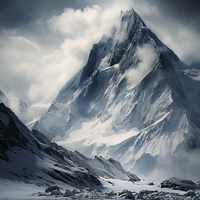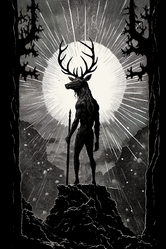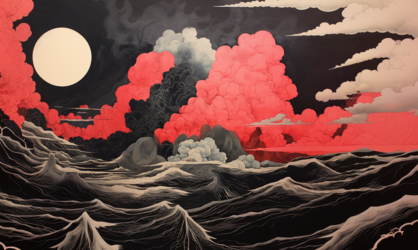Hergom ep swekorwos: Difference between revisions
| Line 342: | Line 342: | ||
|''"Hela Maximum Coven"'' tapestry depicting the myth of the dead rising during Hela maximum to prey on the wayward. 6120s | |''"Hela Maximum Coven"'' tapestry depicting the myth of the dead rising during Hela maximum to prey on the wayward. 6120s | ||
|''"Final Struggle"'' Bind era painting about the ultimate faith of the eternal struggle. 7578 | |''"Final Struggle"'' Bind era painting about the ultimate faith of the eternal struggle. 7578 | ||
|"Crushing defeat" Political commentary painting - 7664 | |"Crushing defeat" Political commentary painting post second coalition war - 7664 | ||
|- | |- | ||
|[[File:Dlrochp1.png|frameless|250x250px]] | |[[File:Dlrochp1.png|frameless|250x250px]] | ||
Revision as of 21:33, 10 December 2023
| Hergom ep Swekorwos Hergom ep Swekorwos | |
| Flag | Coat of arms |
|---|---|

|

|
| Motto: "At the world's very edge, where horizons meet the sky, We rise for our last stand, as the stars bear witness on high. Blood heralds our era, as old tales are undone, For an everlasting dominion, that shall eclipse even the sun." | |
| Anthem: | |
| Locator map | |
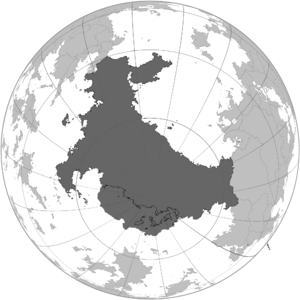
| |
| Capital city | sample_city |
| Largest city | Ombhrosdhom |
| Official language | Wolgos language |
| Other languages | Chala |
| Ethnic group | |
| Religion | 53% Dlroch'veldr
15% Nara Akchacknism 15% indigenous beliefs 13% Venara Akchacknism 4% Neo-Shuocian |
| Demonym(s) | Herg |
| Government | |
| Government Type | Unitary Tribal Federation |
| Your 1st leader title (e.g. King) | President Name |
| Your 2nd leader title (e.g. Prime minister) | Vice President Name |
| Legislature | Congress |
| Establishment | |
| Area | |
| Total | 33,082,896.19 km2 |
| Water % | 4.66% |
| Population | |
| Total | 257,345,233 |
| Density | 7.78/km2 |
| Economy | |
| Economy type | Capitalist |
| Currency | Uhum () |
| Development index | 0.920 |
| Other information | |
| Time zone | All time zones |
| Driving side | Left |
| Calling code | +09999 |
| Internet code | -X00900 |
The premier Wolgos nation in Gotha, known as Hergom ep Swerkorwos, is situated in the deep south of the planet. It encompasses the entire region of Kupeya (called Khrupeva by the Wolgos), which includes the South pole, as well as the southernmost part of Tzeraka (called Therakha by the Wolgos). The nation recently celebrated its centenary anniversary, marking the foundation of the state after the dissolution of the Bind and Dhownolgos. Its establishment followed the conclusion of the Pan Oceanic War and the subsequent Second Great Wolgos Trek.
Despite its extensive land area, Hergom ep Swerkorwos primarily experiences challenging climates. Only around fifteen percent of its territory enjoys a temperate climate, while the remaining land is divided into alpine, taiga, tundra, and varying degrees of harsh arctic climates.
The governance of Hergom ep Swerkorwos departs from the monastic and theocratic systems of its predecessors. Instead, the nation is administered by a federated cabal of Wolgos tribes. While tribes often dominate significant stretches of territory, no Weikosa (region) is monopolized by any particular tribe. Tribes are recognized as legal entities with extraterritorial authority, representing the Wolgos and their human subjects. They encompass numerous clans and families, providing economic, legal, and welfare support.
The state does not provide comprehensive welfare services. Instead, the responsibility for healthcare, education, legal aid, security, and economic assistance lies with the tribes. The level of services varies among tribes and is often tied to their economic influence. Wolgos tribe members frequently work in their respective tribes' expansive enterprises or establish businesses associated with their tribe. However, it is not uncommon to find Wolgos working for tribes other than their own, effectively becoming adoptive members of the tribe they collaborate with.
Cities in Hergom ep Swerkorwos are vibrant hubs where diverse tribes cooperate to conduct efficient business. However, conflicts and hostile competition can arise. The government serves as a pseudo tribe composed of representatives from all tribes, working to harmonize relations and maintain a regulatory and legal framework that supports efficient industry and business operations throughout the nation.
While tribes handle most internal affairs, the government retains control over defense, monetary policy, currency minting, the legal system, relief efforts, intelligence operations, and foreign policy. Defense, infrastructure investments, and intelligence comprise the largest government expenditures. To fund its operations, the government imposes a percentage of revenue and various taxes and fees on the tribes for the services it provides.
As part of its foreign policy, the government exercises control over a number of sorikwentom (corporations and associations). Some of these entities are known to oversee twenty-seven major criminal networks across Gotha. These corporations engage in illicit activities such as distributing drugs, arms manufactured in Hergom, and a range of other illegal operations. The significant profits generated from these activities contribute to Hergom's foreign currency reserves.
Etymology
"Hergom ep Swekorwos" can be interpreted as "Enduring Strength at the World's End" or "Resilient Power at the Edge of the World." It conveys the idea of a powerful and enduring Wolgos nation located in a remote and distant region.
7598 - 7603 Wolgos Scourge (20's to early 30's tech leap) 7603 - 7620 Second Wolgos Trek 7608 Foundation of hergom
History
- Main article: History of Hergom
- See also: Dhonowlgos and The Bind
Pre-Wolgos History
Kupeya's history is marked by limited development due to its harsh environment. The northern coast had temperate land, but the variable climate rendered the colder interior inhospitable. Modest Chalam princedoms emerged along the coast, subsisting on farming and trade with the Raian archipelago. Inland, there were hunter-gatherer villages and trading communities by rivers. The advanced Phula and Alutean peninsula had stone temples and fortified villages. Alutea's progress stood out due to Ithrien's colonial influence. Kupeya's isolation was shaped by its polar proximity and the Raian archipelago, known for its rainforests, trade, and piracy. Despite bordering Kupeya, dense rainforests deterred colonization unlike neighboring regions.
7603 - 7620 - Second Wolgos Trek

After the Wolgos Scourge, Kupeya underwent a significant transformation known as the Second Wolgos Trek. The Peleykros peninsula became a hub for Wolgos migrants, reshaping the region.
Following the devastation, the Bind navy orchestrated a massive migration, relocating people and machinery from Altaia. They collaborated with Kamura and others, despite facing financial ruin. The arrival of the first Wolgos on Kupeya's shores left a handprint emblem, now on the nation's flag, commemorating the event.
Around forty million Wolgos and three million Shriaav were transported from Altaia to Kupeya over fifteen years, a complex logistical operation. However, eight million Wolgos remained in Altaia, and two million dispersed across the Shangti region, May of whom have migrated to Hergom in the subsequent decades.
Initially, challenges arose in Kupeya due to clashes with locals and limited resources. Import reliance decreased, pushing the Wolgos to adapt. The Wodranis river plains became pivotal, providing sustenance through native wildlife and the use of the indigenous population as food.
Infrastructure developed, with fishing ports and docks along rivers established by the remaining Bind administration. These developments supported settlements and resource transportation to Ombhrosdhom, evolving into a thriving city during Kupeya's transformation.
7608 Foundation of Hergom ep Swekorwos
7632 - 7634 First Coalition War
7663 - 7664 Second Coalition War
7664 - First use of nuclear weapons in Ephesus Front by the Coalition
7664 - End of the Second coalition war
7665 - Establishment of the Tzeraka demarcation border
7672 - First Wolgos nuclear Test
7681 - Non-Proliferation Treaty
7689 - Current Era
Geography
Hergom, a sprawling behemoth on Gotha, holds the distinction of being the largest nation, with an impressive expanse spanning over 30 million square kilometres. Its sheer size alone commands attention, yet this vast dominion is an array of contrasting landscapes.
The Kupeyan coast in the north serves as a verdant oasis within Hergom's otherwise challenging terrain. It is in these lands that the nation's most productive biomes flourish, offering respite from the inhospitable surroundings. Here, amidst the temperate embrace, boral forests, oceanic realms, and subtropical zones coexist, yielding an abundant harvest of grains, meats, and an array of fruits. These lush heartlands are the lifeblood of Hergom, sustaining its population and driving its economy.
In the tzerakan territories, one encounters a starkly different environment, characterized primarily by boreal landscapes. Despite the harsh climate, Hergom has defied the odds, successfully establishing livestock farms and cultivating hardy crops. This tenacity is a testament to the indomitable spirit of Hergom's people, who have harnessed even the harshest of northern realms.
Hergom's dominion extends all the way to the planet's southern pole, where an immense icecap blankets the region. Hergom has established thriving colonies on the numerous islands and rugged mountain ranges that anchor this icy expanse. Here, specialized settlements thrive, dedicated to mining and military operations, ensuring Hergom's strategic presence in this frigid frontier.
In the extreme north of Kupeya, particularly in Alutea, thin coastal bands reveal a surprising tropical contrast. Here, tropical savannahs and wet climates create a niche haven, providing Hergom with an unexpected bounty of tropical produce. Coffee, bananas, and pineapples flourish there, adding a touch of exoticism to Hergom's diverse harvest.
Government
- Main article: Government of Hergom
- See also: Wolgos political theory
Hergom ep Swekorwos stands as a distinctive nation, distinct from the theocratic traditions of old Dhownolgos and the monastic military dictatorship of the Bind. During the first years of settlement on kupeya, power shifted away from a Hlrike monopoly, and the traditional Wolgos tribal identity gained empowerment. This transformation was driven by the necessity for tribes to practice autonomy in the early years, characterized by scarce infrastructure and effective administration. As a result, Hergom evolved into a state ruled as a corporate entity with a council comprising tribal representatives and the Hlrike in an advisory capacity. However, it remains an autocratic state with a highly competitive meritocracy at its core.
At the heart of this government structure lies the Gweḱwōntiyo Hregwes, the Tribal Council, wielding all power, and the coveted position of Heghnom Kawisoos, the State Director.
The Gweḱwōntiyo Hregwes, known as the Tribal Council, stands as Hergom's exclusive legislative body, defining Hergom as a unicameral legislature. Within this structure, the Hregwis Wl̥kwos, or Council Wolves, emerge as vital figures, representing not only their respective tribes but also acting as advocates for the entirety of Hergom's citizenry. Though Hergom's populace exceeds two hundred and a half million, their interests find voice through the ninety-six Wl̥kwos, resulting in three representatives per tribe. While tribes exhibit comparable sizes, smaller ones possess a somewhat disproportionate but essential overrepresentation. These Wl̥kwos, often the tribal leaders, are designated by their tribes, serving as conduits of collective voices. Each Wl̥kwos is tasked with appointing a Dhegwhom Xḱtis, or forum office, reinforced by secretaries to facilitate communication between tribe members and their representatives. Beyond this, the forum offices are equipped with dedicated bureaus overseeing the intricate affairs of the tribe's individual clans.
The Heghnom Kawisoos, State Director, holds tremendous authority and is the pinnacle of ambition for many Wolgos individuals. The path to this position is fiercely competitive, requiring mastery of negotiation, manipulation, statecraft, and subterfuge. While the State Director holds a lifelong position, it is common for them to be deposed after a few years or decades, allowing for the ascension of more dynamic Wolgos leaders. A deposition is not considered shameful, but rather an opportunity for retirement and respite.
The tribes and their member clans play a vital role in maintaining the stability of the state and the well-being of individual Wolgos. Each tribe holds a designated geographical area of influence, aligning roughly with a Weikosa, or province. Within their respective Weikosas, tribes wield considerable influence, although it is not uncommon for different tribes to share influence and hold economic interests in each other's territories. Cooperation and harmonious coexistence are prevalent, with tribes frequently sharing settlements, towns, and cities. This spirit of collaboration extends to industry and commerce, although larger businesses tend to be dominated by a single tribe.
Justice and Law
Theory
Criminal Theory
At the heart of the Wolgos legal framework lies a strategic approach, a reflection of their innate psychopathic tendencies. For the Wolgos, crime is not solely an act that disrupts social harmony but rather one that upends the delicate balance of power and authority. Actions that threaten the interests of the state, society, tribe, or influential individuals are marked as criminal, mirroring their stratified society where not all Wolgos are equal in the eyes of the law.
However, the determination of what constitutes a crime isn't solely rooted in strategic considerations. Established Wolgos norms, often intertwined with religious dogma, play a significant role in shaping the boundaries of acceptable behavior. The teachings of Dlroch'vlder serve as a moral compass, guiding the complex interplay between morality and strategic considerations.
The Wolgos, though not innately collectivist, have developed a strategic collectivist perspective through their evolution within larger and more intricate societies. Adhering to established moral norms has become crucial as they navigate these complexities. Dlroch'vlder's teachings provide a shared ethical foundation, allowing the Wolgos to construct a unique sense of morality in the midst of shifting power dynamics.
Within Wolgos society, a notion of general rights and expectations for the Wolgos alone exists, though tinged with nuances. Equality isn't uniform; instead, a spectrum of equality prevails, where certain individuals are inherently more equal than others. This hierarchy aligns with the strategic nature of their society, where power and influence intricately shape the definitions of right and wrong.
It's important to note that these intricacies may not seamlessly apply to interactions with humans. The Wolgos moral code, intricately woven into their psyche, might not readily translate to human norms. What's deemed a crime or moral transgression in their society may lack translation or comprehension when projected onto human behaviour.
Judicial theory
The concept of justice among the Wolgos differs significantly from that of humans, as their understanding revolves around the notions of harmony and continuity rather than equity and righteousness. Retributive or punitive justice does not serve as the guiding principle for Wolgos justice; instead, they gravitate toward what can be termed as strategic justice.
Interestingly, most actions that may be perceived as crimes are addressed through restorative justice practices, with the aim of restoring collective balance and harmony. The well-being of collective interests takes precedence over the individual's injury. The extent and involvement of restorative practices are highly contingent on the influence wielded by individual Wolgos, their kin, or their tribe. Lone individuals without a close social collective or those of low standing and influence often find themselves at a disadvantage and face significant punitive risks.
Within Wolgos societies, there is no impetus to address power imbalances that disadvantage isolated or low-standing individuals. This is primarily because doing so would diminish the influence and degree of impunity that families, clans, and tribes can leverage. Furthermore, this system of justice serves as an important social mechanism that helps the Wolgos overcome potentially antisocial tendencies. It fosters the need for cooperation and the stability of family, clan, and tribal structures, thereby ensuring the stability of the state itself.
One disadvantage of this system, from a human perspective, is the vast disparity in how crimes are punished or resolved. Grave crimes can go unpunished if influential or powerful individuals exercise significant impunity, particularly if the injured party holds little social capital or importance. Individuals of low standing or social capital can face insurmountable obstacles to justice and are at high risk of exploitation or harm.
It is worth noting that the state is the only party that can achieve complete restitution if injured. Charges brought by the state are usually challenging to dispute, as a crime against the state is seen as a crime against Wolgos kind. Nevertheless, there are checks and balances in place, as they are in the best interest of the state. Wolgos societies can engender a collective sense of paranoia if they perceive the interests of tribes to be threatened.
Collective Accountability
Accountability can extend beyond individual responsibility to include collective accountability. Clans or tribes can be held responsible for the actions of their members, fostering a sense of collective responsibility and encouraging internal mechanisms for addressing conflicts and ensuring compliance with community norms.
Administration of justice
The judicial system of Hergom, a sprawling domain defined by its intricate societal fabric, operates through a three-stage framework that blends age-old traditions with contemporary adaptations. With an emphasis on harmonious resolutions and the preservation of collective well-being, this system navigates disputes through mediation, court arbitration, and appellate review.
Restorative Justice - Mediation Pathway
At the core of Hergom's legal philosophy lies a profound commitment to restorative justice. Grounded in the decentralized nature of its judicial structure, the system places mediation and reconciliation at the forefront of dispute resolution. Conflicting parties are granted the opportunity to seek common ground through negotiation, facilitated by skilled and accredited mediators. The primary objective remains the restoration of harmony and cohesion, with punitive measures taking a back seat.
Mediation occurs within various settings, ranging from dedicated mediator chambers to mutually agreeable locales. To formalize resolutions, notaries and witnesses often preside over the final stages.
The Court for Dispute Resolution
Should mediation's path prove impassable, disputes find their way to the courts for arbitration by a qualified judge. This phase carries with it specified taxes and hourly charges, necessitating meticulous preparation by all involved parties. The involvement of mediator representation is strongly recommended, lending an expertise to the proceedings. Drawing from a blend of state and tribal customary laws, the courts administer justice within their respective communities.
It is important to note that the courts' realm extends beyond mere disputes. Individuals facing charges initiated by the state or law enforcement entities often find themselves in the initial embrace of the court. However, even in these circumstances, mediation remains the preferred avenue, aiming to foster a resolution between the accused and the state. Should this pursuit fall short, the court's role is activated, with the accused bearing the onus of any relevant fees and hourly expenses.
Courts of Appellate Review
Dissatisfied parties or individuals may seek recourse through the courts of appellate review, provided legal provisions permit. Yet, this path to redress is not devoid of considerations. The pursuit of appellate review entails financial implications, often necessitating collateral commitments. Appellate courts stand as a platform to scrutinize lower court decisions, rectifying errors or rights violations.
Judicial Debt
In Hergom, the path of justice intertwines with fiscal responsibility through the concept of judicial debt. As legal proceedings unfold, financial obligations emerge for parties involved. Those unable to meet these commitments face a meticulous process of debt recovery, which may involve asset liquidation. Tribes, essential to Hergom's social fabric, can also be called upon to share the burden of settling debts. Should conventional measures falter, the judiciary can impose sentences of labor benefiting the state or earnings garnishing.
Law Enforcement
Military
- Main article: Military of Hergom ep Swekorwos
Hergom, a nation with a unique military landscape, boasts the largest government expenditure on its armed forces, consuming over 45% of its national budget. At the heart of this formidable military machine are the dedicated and highly-trained Wolgos service men, who not only defend their homeland but also contribute significantly to the nation's employment statistics. The industrial military complex in Hergom is expansive, operating at a capacity that ensures constant war readiness while catering to the needs of allies and foreign customers alike.
In the present day, Hergom maintains a standing army of 2.2 million active service personnel, making it one of the world's most professional and well-equipped armed forces. The substantial investment in equipment and training has earned it the reputation of being one of the costliest government services. Armored vehicles and high-mobility units are the backbone of this military, effectively safeguarding the nation's extensive territory. Additionally, artillery stands ready at the border regions, serving as a deterrent with the capability to unleash a barrage against civilian targets in the event of an invasion.
Hergom's naval capabilities are equally distinctive, with two separate fleets in operation. Geographical considerations, including the prohibition on using the Phasian canals for military purposes, have led to the establishment of the Arctic-Asherian Navy, tasked with defending Hergom's vast northern coast. Operating under the challenging Arctic conditions, this navy relies heavily on submarines. The Phasian Navy, on the other hand, focuses on a defensive role and is undergoing expansion to enhance its blue water capabilities.
The role of the airforce cannot be overstated, particularly in a nation as geographically diverse as Hergom. Zepellins play a crucial role in transporting heavy equipment across the southern ice cap and vast expanses of the country during times of peace. Hergom has invested significantly in modern and cutting-edge airforce technology, including fighter jets. However, there have been allegations from certain states that some of this technology may have been acquired through less-than-savory means, potentially hinting at espionage from more powerful nations such as Arvor or Livaria.
Notably, Hergom is also recognized as a nuclear power, a status it has held for more than three decades. Following intensive diplomatic negotiations through the International Committee on Nuclear Non-Proliferation (ICoN), Hergom became a signatory to the non-proliferation treaty. This commitment entails adherence to nuclear power stockpile limitation quotas and a pledge to abstain from using Intercontinental Ballistic Missiles (ICBMs). However, suspicions linger that Hergom may have found creative ways to skirt these restrictions by equipping such projectiles onboard submarines, greatly extending their range and raising concerns among the international community. Hergom's nuclear capabilities remain a subject of scrutiny and diplomatic tension, even as the nation strives to balance its defense needs with international obligations.
Demographics
Ethnicity
- Main articles: Wolgos Tribes and Wolgos
Hergom, a multiethnic nation with a population of 257 million people, presents a complex societal landscape marked by stark ethnic disparities. The most prominent ethnic group in Hergom is the Wolgos, a distinct homid species separate from humans, though often considered a subspecies. With approximately 152 million members, the Wolgos wield considerable influence and power, firmly in control of the state apparatus. Their dominance has led to the subjugation of other ethnic groups, each experiencing varying degrees of privilege and marginalization for the benefit of the Wolgos elite.
Among Hergom's ethnic diversity, the Shriaav stand out as a group of 12 million individuals who arrived in Kupeya alongside the Wolgos during their exile from Altaia. Descended from loyalist and elite members who collaborated with the Wolgos, the Hergom Shriaav enjoy nearly identical rights and privileges to their Wolgos counterparts. However, they remain notably absent from government and military positions. Their culture has evolved to mirror many of the Wolgos norms, including the formation of tight-knit cliques that establish hierarchies through violence and the garnering of control and respect within their respective groups.
The Chalam, the indigenous people of Kupeya, faced a tragic history during the era of Wolgos settlements. Their population was outcompeted, decimated, and subjected to horrific treatment, including being used as sustenance by the Wolgos. Presently, their population has recovered but remains at around 21 million, holding on to their unique cultural heritage despite the challenges they've faced.
The Gahnam, numbering around 53 million, constitute the second-largest ethnic group in Hergom. They primarily serve as laborers, with tribal elites governing many aspects of their lives under the overarching authority of the Wolgos state. Their culture is deeply rooted in Akchacknism, an ancient belief system that has withstood the test of time.
The Utura, a relatively recent subject ethnic group of the Wolgos, share the plight of laboring for the Wolgos' benefit. Despite their technical freedom, they are subjected to stringent labor laws, maintaining their role as a labor force for Hergom. Their population stands at around 15 million.
In a deeply troubling and inhumane context, the Eokoesr, numbering approximately four million, find themselves in a state of extreme subjugation. Descendants of those who were brought to Kupeya in chains by the Wolgos, their existence is characterized by abject humiliation and despair. While the Wolgos officially deny their existence or their enslavement, circumstantial evidence suggests that they endure lives akin to beasts of burden and livestock, reminiscent of the horrors of old Dhownolgos.
| Ethnic Groups of Hergom | |||||
|---|---|---|---|---|---|

|

|

|
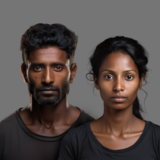
|

|

|
| Wolgos | Hergom Shriaav | Chalam | Gahnam | Utura | Eokoesr |
Religion
Economy
Labour
Women and Labour
Hergom's pronatalist policy has left an indelible mark on the nation's labour landscape. The policy places significant emphasis on procreation. Wolgos women are strongly encouraged to bear a substantial number of children before reaching the age of thirty. The cultural norm dictates that a woman should have at least five children by this age to fulfil her societal role.
As part of the pronatality policy, Wolgos women face strict labor restrictions. Those who have not given birth to at least three children or have not reached the age of forty-five are not permitted to engage in formal employment or labor outside their homes.
To supplement family incomes, many Wolgos women turn to informal entrepreneurial activities that allow them to work from home while fulfilling their roles as homemakers and caregivers. These ventures include cooking and selling food, providing seamstress services, child and elder care, and similar undertakings.
In recent decades, women have found opportunities as home sales representatives for various companies. They sell products to other women and families, often building extensive sales networks. These companies have become pervasive in Hergom and provide opportunities for women to access literacy and numeracy education through study groups organized by the companies.
Formal education for Wolgos women has not traditionally been a priority, leading to a significant portion of the female population lacking basic literacy and numeracy skills. Instead, their education primarily occurs within the household. While some Wolgos women do manage to access formal education, including higher education, it remains a challenging endeavour. Access to higher education typically relies on experts in the field taking on students as interns. Unfortunately, women are often overlooked as suitable candidates for these internships, leading to gender disparities in higher education.
Human Labour and Abolition of Slavery
For millennia, the Wolgos society relied heavily on forced labour and slavery to sustain its economy and way of life. However, significant changes occurred after the conclusion of the Second Coalition War and Hergom's accession to the International Council of Nations (ICoN). Slavery, once deeply ingrained in Wolgos culture, was officially abolished as the nation sought integration into the global community to advance its objectives.
The decision to end slavery was not entirely voluntary. Pressure from the international community, particularly exerted through ICoN, played a pivotal role in bringing about the abolition. The end of slavery was closely tied to the cessation of numerous trade, financial, and diplomatic sanctions imposed on Hergom. Additionally, it helped diffuse the critical tension that had arisen following Hergom's attainment of nuclear capabilities a year earlier, averting potentially catastrophic consequences.
Despite the abolition of slavery, Hergom did not transition into an era of emancipation and unbridled freedom. New legislation accompanied the abolition, imposing heavy unemployment taxes and penalties on non-Wolgos and non-Shriaan individuals. These penalties often included mandatory periods of indentured work for the state. Consequently, a multitude of employment agencies emerged to assist newly freed individuals in securing employment.
Human employment agencies have become integral to the post-abolition landscape. These agencies typically deduct a portion of the salary earned by the humans they represent. Furthermore, workers are often required to purchase most of their necessities from company-operated shops and catalogs. Once an individual signs with an employment agency, they are bound to work assignments determined by the company. Changing agencies is a challenging endeavor, requiring adequate reason and the signed dispensation of a sheriff. Fierce competition between these agencies has led to human resource officers becoming adept at facilitating agency changes.
While salaries are now provided, they remain low and subject to state regulation. Nevertheless, individuals with higher skills and experience command higher wages. Despite the newfound ability to earn wages, accumulating savings or acquiring real estate remains nearly impossible for many. The agency system often sells goods and services to workers at marked-up prices and takes substantial cuts from their salaries, making economic advancement a challenging endeavor.
The abolition of slavery in Hergom marked a significant turning point in its history, reflecting the nation's aspirations for global integration. However, the complex aftermath of abolition, characterized by stringent labour laws, limited economic mobility, and the rise of employment agencies, underscores the multifaceted nature of societal change and the enduring challenges that emerged in its wake.
Foreign Labour
Hergom, a nation inhabited by the Wolgos, faces a unique set of challenges resulting from its rapid population growth and resource consumption. With a staggering population growth rate of nearly 3% annually and the Wolgos demanding between 30% to 200% more basic resources than the average human, Hergom has experienced tremendous pressure to expand its infrastructure, develop farmland, and boost its industrial capacity.
This population explosion has led to a significant labor shortage within Hergom. To address this pressing issue, creative and collaborative solutions have emerged. One such solution involves friendly nations, including Bule, permitting human employment agencies to recruit workers within their territories. Incentives are provided to these agencies in the form of minimal remittance guarantees to support the families of recruited individuals in their home countries.
Hergom has also found innovative ways to alleviate the burden of its corrections and incarceration sectors. Friendly nations, seeking to reduce their incarceration costs, enter agreements with Hergom. In these arrangements, low and medium-level inmates are hosted in specialized work camps within Hergom for the duration of their sentences. Furthermore, sentences may be extended based on behavioral infractions.
For high-level criminals, life sentence convicts, and those sentenced to death in their home countries, Hergom employs a distinctive approach. Death sentences are suspended, and prisoners are assigned to lifelong labor sentences in potentially hazardous enterprises. In certain cases, Hergom pays the prisoner's home country a lump sum for their transfer. Foreign nations may enjoy reduced incarceration costs and even share in dividends, depending on their willingness to subsidize certain living standards.
While the collaboration offers economic benefits to foreign nations, being a foreign prisoner in Hergom presents challenges. Conditions in Hergom's work camps are often spartan, with multination inmates mixed together. High work quotas and long workdays are common, highlighting the demanding nature of the arrangement.
Culture and Art
- Main article: Wolgos Cuisine and Cuisine in Hergom
Visual Arts
Music
Literature
Education
Sport
- Main article: Sports in Hergom

In Hergom, the state places a significant emphasis on the development of Wolgos athletes and the promotion of sports among Wolgos citizens. This commitment is evident in various policies and practices that ensure Wolgos participation in sports remains a central aspect of their lives. The government, through laws and subsidies, compels tribes to allocate resources to the establishment of ubiquitous gyms and sports facilities, all with the primary purpose of catering to the enjoyment and physical development of the Wolgos populace.
Across the nation, clan facilities incorporate gym provisions as a standard feature, with men socially compelled to cultivate their physical prowess. The expectation is clear: Wolgos men should be prepared for sustained physical activity and should possess proficiency in brawling skills. Tribal facilities often go a step further, offering advanced amenities like pools and physiotherapy, reinforcing the commitment to physical well-being.
While Bhutsworos and Xorgis maintain their status as the most popular team sports in Hergom, there has been a significant surge in the popularity of martial arts, wrestling, and other foreign sports among a substantial number of men. Notably, bare-knuckle boxing has remained a consistent favorite and has evolved into a popular spectator sport in recent decades.
For women in Hergom, the expectation also revolves around physical activity, albeit with a different focus. Women are encouraged to engage in sports that promote physical fitness while retaining their attractiveness. Activities such as aerobics, cardiovascular exercises, and group jogging with fellow women are the preferred choices. Mixed-gender sports are strongly discouraged, reinforcing the division of sporting pursuits along gender lines.
Hergom's commitment to sports extends beyond the national borders. The nation invests heavily in athletes for the International Mass Games (IMG), viewing the accumulation of gold medals as a means to showcase the perceived superiority of the Wolgos. However, this pursuit has not been without controversy. IMG committees have imposed certain restrictions on the Wolgos athletes, such as the mandatory use of fitted mouth covers to prevent spitting or the use of saliva on opponents. The committees have also intensified their vigilance regarding potential sports doping, amid suspicions that some Wolgos athletes might engage in such practices. Despite the challenges, Hergom remains steadfast in its dedication to sports as a symbol of national pride and Wolgos supremacy.






